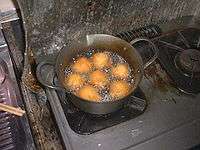Sata andagi
|
A finished sata andagi | |
| Type | Fried dough |
|---|---|
| Place of origin | Japan |
| Region or state | Okinawa |
| Main ingredients | Flour, sugar and eggs |
|
| |
Sata andagi (サーターアンダーギー Saataa andaagii) are sweet deep fried buns of dough similar to doughnuts (or the Portuguese malasada, or the Dutch oliebollen), native to the Japanese prefecture of Okinawa. They are also popular in Hawaii, sometimes known there simply as andagi. Traditional Okinawan andagi is made by mixing flour, sugar and eggs. The ingredients are mixed into a ball and deep fried.
Saataa means "sugar", while andaagii means "deep fried" ("oil" (anda) + "fried" (agii)) in Okinawan (satō and abura-age in Japanese.) It is also known as saataa andagii and saataa anragii.
Sata andagi are a part of Okinawan cuisine. Like most confectionery from the Ryukyu Islands, the techniques for making them are descended from a combination of Chinese and Japanese techniques,[1] They are typically prepared so that the outside is crispy and browned while the inside is light and cake-like.
 A batch of sata andagi being deep fried
A batch of sata andagi being deep fried
See also
References
- ↑ http://www.wonder-okinawa.jp/026/e/kashi.html Okinawan tourism site.
External links
| Wikimedia Commons has media related to Sata andagi. |
